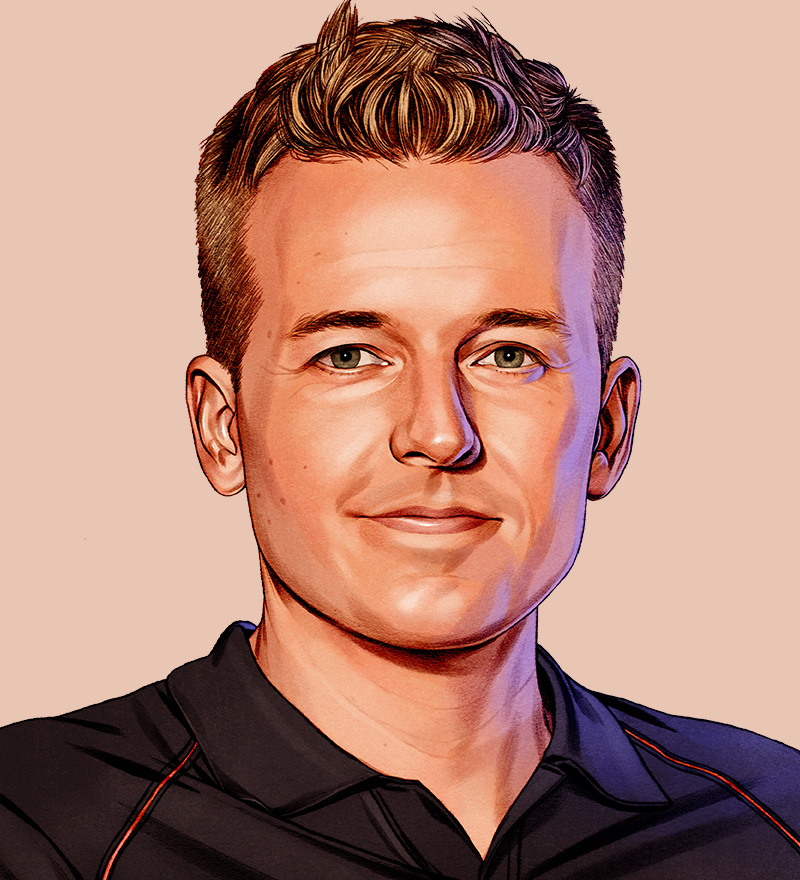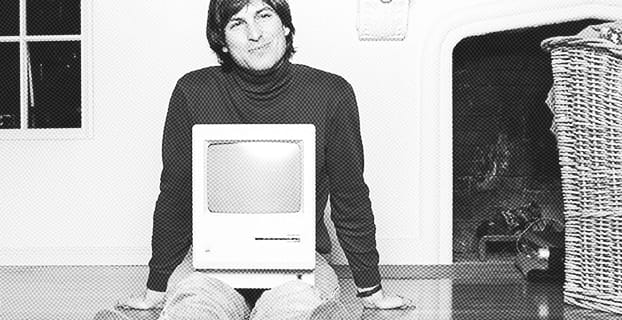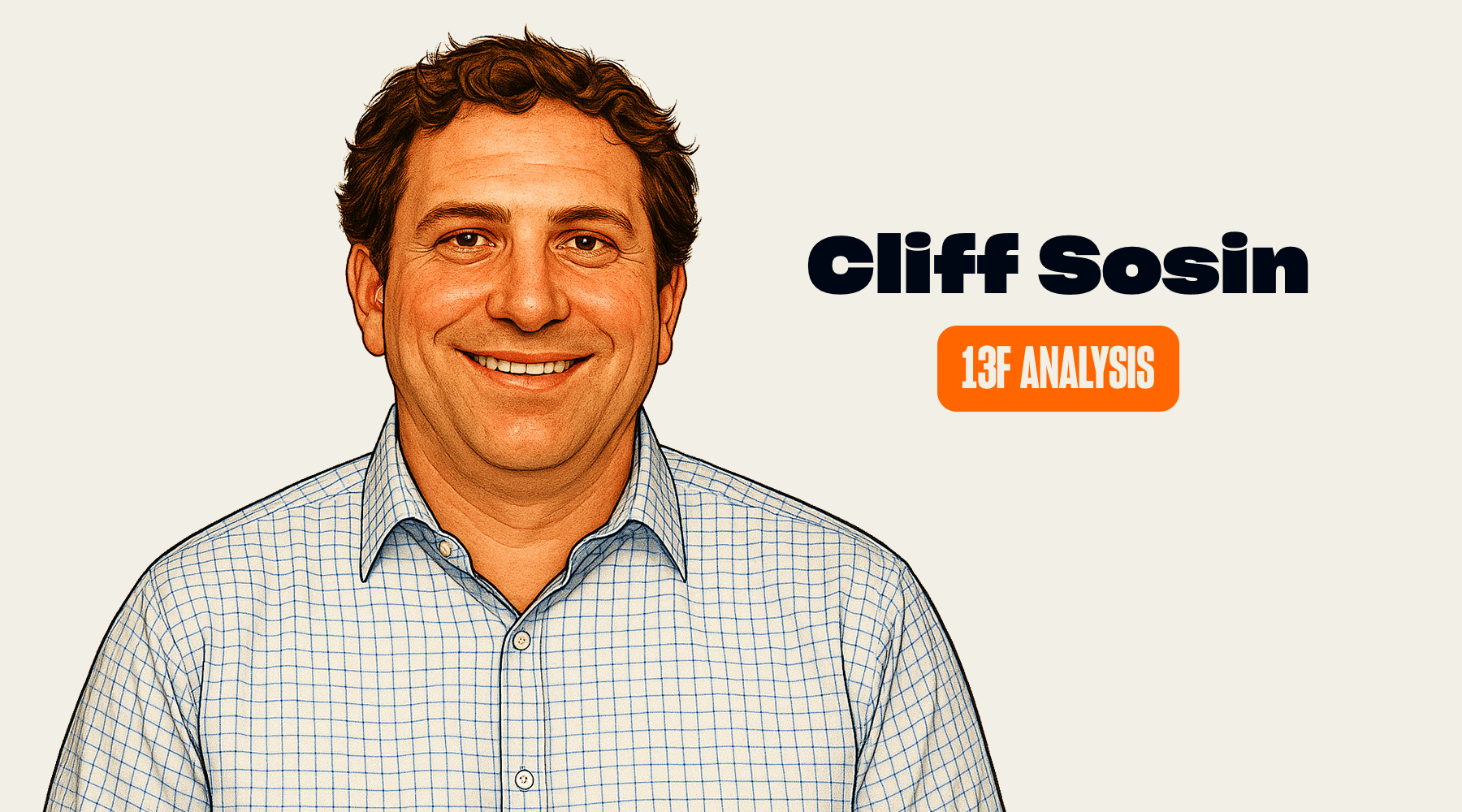Steve Jobs is most well known as the co-founder, chairman, and CEO of Apple — building it from a small upstart into a multi-billion dollar company. He was also the Chairman and majority shareholder of Pixar, as well as a member of The Walt Disney Company's board of directors following the Pixar acquisition. He created the world's first technology company that was vertically integrated and emphasized both incredible technology and incredible design, creating devices that were both incredibly easy to use and incredibly powerful. He's a hero of mine and someone I draw immense inspiration from in my work.
Quotes from Steve Jobs
“Think of your life as a rainbow arcing across the horizon of this world. You appear, have a chance to blaze in the sky, and then you disappear.”
“Be a yard stick of quality. Some people aren’t used to an environment where excellence is expected.”
“Recruiting is the most important thing that you do. Finding the right people, that is half the battle.”
“I've never believe that they're separate. Leonardo da Vinci was a great artist and a great scientist. Michelangelo knew a tremendous amount about how to cut stone at the quarry. The finest dozen computer scientists I know are all musicians. Some are better than others, but they all consider that an important part of their life. I don't believe that the best people in any of these fields see themselves as one branch of a forked tree. I just don't see that. People bring these things together a lot. Dr. Land at Polaroid said, "I want Polaroid to stand at the intersection of art and science," and I've never forgotten that. I think that that's possible, and I think a lot of people have tried.”
“There’s lots of ways to be, as a person. And some people express their deep appreciation in different ways. But one of the ways that I believe people express their appreciation to the rest of humanity is to make something wonderful and put it out there.”
“And you never meet the people. You never shake their hands. You never hear their story or tell yours. But somehow, in the act of making something with a great deal of care and love, something’s transmitted there. And it’s a way of expressing to the rest of our species our deep appreciation. So we need to be true to who we are and remember what’s really important to us.”
“Technology alone is not enough.”
“The more we look at it, for more and more consumer devices the core technology is going to be software. More and more they look like software in a box. And a lot of traditional consumer-electronics companies haven’t grokked software.”
Apple’s Reason For Being
On October 29, 2000, Steve Jobs sent himself an email — as he often did — on Apple’s “reason for being.” It beautifully encapsulates why he loved Apple and the impact he aspired to have on the world.
From: Steve Jobs
To: Steve Jobs
Subject: Apple’s reason for being
Date: October 29, 2000, 4:39 p.m.
Apple is the world’s premier company at building high technology products that are easy to learn and use by mere mortals. Beginning over 20 years ago, Apple has consistently set the standard for easy to use computer systems and software. Why do we do this? Because we are in love with the potential for personal computers to enhance and enrich the lives of regular people - not just with spreadsheets and databases, but with creative.
We’re a creatively driven company in everything we do. From breakthrough product features and operating systems to culturally leading product design and advertising. Heck, we INVENTED the personal computer, spawned desktop publishing and are now bringing desktop movies to millions. And our engineers are hard at work on several more exciting breakthroughs you’ll see in 2001.
Apple marries state of the art technology with Apple’s legendary ease-of-use to create products that enable users to do more.
Apple is the world’s premier bridge builder between mere mortals and the exploding world of high technology. Apple enables mere mortals around the world to grasp by making it easy to learn and use.
Apple is the premier company in the world at making the exploding world of high technology easy to learn and use, thereby enabling mere mortals to enrich their lives using it.
Demystified technology, it will have a much greater impact than any other thing we can do. The stores need to be thought of as a mecca for understanding technology and making all of the digits a part of your life. All things digital, digital music, digital photography, people who’ve migrated to broadband, people/families who want to build a home network.
More than a year earlier on January 24, 1999, Steve Jobs sent an email to Apple employees celebrating Macintosh’s 15th birthday. It included this reflection on Apple’s role in bring cutting technology to the world:
While I am not normally one to look back, today is a good day to remember Apple’s legacy, which is to bridge the gap between sophisticated technology and “the rest of us” who make up most of humanity. It’s our job to make complex technology easy to use and fun to use. The need for this bridge is even greater today than it was in 1984 when the Macintosh debuted. Back then, users didn’t have to deal with the complexities of connecting to networks and the Internet, setting up email, managing device drivers and init files, and all of the other things that drive today’s computer users mad.
The computer world shows no signs of getting simpler as we enter the coming century. And no other company has yet taken Apple’s place as the bridge builder. As we return to our roots and once again begin delivering simpler and better ways to use computers, Apple’s future looks both bright and secure.
For more, read my full book summary for Make Something Wonderful: Steve Jobs In His Own Words.
My Favorite Emails from Steve Jobs
One of my all-time favorite emails that Steve Jobs sent the team at apple is this one celebrating the day Apple’s market cap surpassed Microsoft. Get back to work.
From: Steve Jobs
To: Apple employees
Subject: Today
Date: May 26, 2010, 5:59 p.m.
Team,
As most of you already know, at the close of today’s stock market, Apple’s market cap (stock price × number of shares) surpassed Microsoft’s market cap.
As I once said in a company email sent a long time ago: “Stocks go up and down, and things may be different tomorrow, but I thought it was worth a moment of reflection today.” And so it is again.
Walt Disney used to say to his team: “We’re only as good as our next picture.” Well, we’re only as good as our next amazing new product.
Back to work…
Steve
This is a wonderful short meditation on life and how dependent we all are on one another.
From: Steve Jobs
To: Steve Jobs
Subject:
Date: September 2, 2010, 11:08 p.m.
I grow little of the food I eat, and of the little I do grow I did not breed or perfect the seeds.
I do not make any of my own clothing.
I speak a language I did not invent or refine.
I did not discover the mathematics I use.
I am protected by freedoms and laws I did not conceive of or legislate, and do not enforce or adjudicate.
I am moved by music I did not create myself.
When I needed medical attention, I was helpless to help myself survive.
I did not invent the transistor, the microprocessor, object oriented programming, or most of the technology I work with.
I love and admire my species, living and dead, and am totally dependent on them for my life and well being.
Sent from my iPad
It's Time to Get Serious
In 1997, Steve Jobs returned to the helm at Apple. Apple had lost $800M in the previous year and his return was later described as "a study in focus." Soon after he returned, he slashed the company’s product offerings from 17 to 4. This upset some fans and led to thousands of job losses, but he was unwavering in his belief that it was necessary to save the company. “You’ve got to choose what you put your love into really carefully,” he said at the time.
Steve was not yet CEO when he sent a company-wide email laying out plans to take Apple back to its roots.
__From: Steve Jobs
To: Apple employees
Subject: A More Entrepreneurial Apple
Date: August 12, 1997, 8:20 a.m.
Renewing Apple is a journey, and we have begun that journey during the past four weeks by taking some decisive first steps—a new Board of Directors, a new product strategy and product roadmap, a decision to really focus on two market segments (education and creative content), a new advertising agency, and a detente and working partnership with Microsoft. Last week we announced some of these steps at MacWorld, and so far our shareholders and the public seem to approve.
Today we are taking a few more steps which will begin to take Apple back to its roots as a more egalitarian, entrepreneurial company. They are:
- Stock Options: From now on, we will be using stock options as a primary form of “beyond-salary” compensation. Stock options are egalitarian (when anyone’s stock goes up $1 per share, everyone’s stock goes up $1 per share) and they are the best way to give our employees a true stake in the company’s future success. And, we want our employees to be rewarded by the company’s success in the same way that our public shareholders are: through stock appreciation. To lead the way, the Executive Team has agreed to forfeit their current and future cash bonus plans in exchange for more stock options.As you know, we repriced all stock options to $13.25 on July 11th. In addition, I am pleased to announce that on August 5th our Board approved new stock option grants totaling six million shares at the price of $19.75. Those receiving these new grants will get the good news later this week.Apple has granted stock options for over 10 million shares since the beginning of this calendar year, and employees now hold stock options for over 20 million shares - which is more than 16% of Apple’s total outstanding shares. This is a very high percentage for a company of Apple’s size, and comparable to many valley start-ups. As we restore Apple’s fortunes, our public shareholders and our employee stock option holders will all benefit in harmony.
- New Severance Plan: Effective today, we are changing our severance plan for all employees to be more in line with an entrepreneurial company. There will now be only one severance plan for all employees. This plan, like the previous plans, will provide a 60 day notice period, with full pay and benefits. In addition, employees will be eligible to receive one additional week of severance pay for each full year of service. For example, if you have worked at the company for more than three but less than four years, you will receive your pay and benefits during the 60 day notice period plus severance payments equal to three weeks of pay. This new severance plan applies to all employees of Apple, Claris, and Newton in the US - there is no longer a separate executive severance plan.We will be changing our international severance policies to be in line with this new plan to the extent permitted under local laws.
- Sabbatical Program: Apple needs all hands on deck for the foreseeable future as we turn our company’s fortunes around. We are therefore discontinuing the sabbatical program at the end of our current fiscal year. Employees who have earned their sabbatical as of September 26, 1997, will be eligible to take their sabbatical at a mutually agreeable time during fiscal year 1998. This applies to all employees of Apple, Claris, and Newton worldwide.
- Corporate Travel: Corporate travel will continue to be constrained to essential trips. Our egalitarian travel policy specifies coach class travel for everyone on trips lasting less than 10 hours, and business class travel for everyone on trips of 10 hours or longer. Of course individuals may use their personal funds or mileage awards to upgrade their seating class. For clarification, flights between San Francisco and Tokyo (either direction) are eligible for business class travel.
- Facilities: We will continue to move as many employees as possible onto our R&D Campus site. We will greatly benefit by the resulting “beehive” effects, including faster communication paths and more unplanned interactions between the various groups. Reflecting this consolidation, we are renaming the R&D Campus to the Apple Campus, beginning today.Thank you for your support as we work together to renew Apple.
Steve and the Executive Team
Steve Jobs' Heroes
Steve Jobs was deeply inspired by many founders that came before him including Edwin Land of Polaroid, Akito Morita of Sony, and Henry Ford of Ford. Here's a full list of Steve Jobs heroes who inspired Apple's products and culture.
- Edwin Land: Inventor of the Instant Film Camera and Founder of Polaroid
- Nolan Bushnell: Founder of Atari and Chuck E Cheese
- Robert Noyce: Co-Inventor of the microchip and Co-Founder of Intel and Fairchild Semiconductor
- Andy Grove: Co-Founder of Intel
- Akito Morita: Founder of Sony
- J. Robert Oppenheimer: Lead Scientist of the Manhattan Project
- Henry Ford: Founder of Ford
- Walt Disney: Founder of Walt Disney
- Larry Ellison: Founder of Oracle
Favorite Photos of Steve Jobs
A few of my favorite photos of Steve Jobs from over the years.





Michael Moritz Interview with Steve Jobs
Michael Moritz, a reporter who would soon switch careers and become a venture capitalist at Sequoia, spoke at Steve’s office at Apple in May 1984. They covered a wide range of topics, including Steve’s thoughts on product design.
Steve Jobs: I went around and looked at Cuisinarts when we were designing Mac. It was like my Cuisinart week.
Michael Moritz: But no other particular products influenced you? Say, from the late seventies or something.
Steve Jobs: Well, we’re around automobiles our whole lives. I’ve never been a car guy, but I’ve always loved Volkswagen Beetles. I’ve always loved Volkswagen vans, actually, too.
Just a bunch of little things: wine labels, paintings in galleries. Just simple things. Not anything real profound, just lots and lots of little things. I don’t think my taste in aesthetics is that much different than a lot of other people’s. The difference is that I just get to be really stubborn about making things as good as we all know they can be. That’s the only difference.
Michael Moritz: Yeah, I think you’re being modest.
Steve Jobs: Well, things get more refined as you make mistakes. I’ve had a chance to make a lot of mistakes. Your aesthetics get better as you make mistakes. But the real big thing is: if you’re going to make something, it doesn’t take any more energy—and rarely does it take more money—to make it really great. All it takes is a little more time. Not that much more. And a willingness to do so, a willingness to persevere until it’s really great.
But aesthetics? I think aesthetics are a lot like singing. Joanie Baez has a beautiful voice, but the reason her voice is beautiful isn’t because her voice is just beautiful. It’s because she has an incredibly good ear. She can listen to somebody speak for thirty seconds and imitate their voice almost perfectly. Her ear is superb. And I think, in the same way, good aesthetics result from just your eye. An instinct of what you see, not so much what you do.
Steve Jobs: I want to build products that are inherently smaller than any of the products on the market “today. And when you make things smaller, you have the ability to make them more precisely. Obviously, a perfect example of that is a watch. It’s beautiful, but the precision has to be the scale of the object itself, and so you make it very precise. And as our products get smaller, we have the opportunity to do that. So, obviously, I would like everything to be smaller.
I also think that it’s really nice to be able to carry products around. Even if they’re not portable, it’s very nice to be able to have a handle on them that says, “Pick me up and move me when you want to change where I am.” Carry them from room to room, or from office to office. Lisa’s too heavy to carry from office to office, or room to room, or home on the weekends. So the question is, “How do we find a way to package that same functionality into something that we can carry around with us and that is smaller, obviously—and be able to express the form of that more precisely?” That’s where we’re going in the future, those directions.
Michael Moritz: What are the uglier, offensive designs of products, or are there just too many to list?
Steve Jobs: Yeah—pick any car before three years ago, you know? Pick most cars today. Anything. Just look around the room. Tables, chairs: all ugly. You can ask me, what am I doing in this office? But anyway, most things are not very nice.
The telephone’s a perfect example. The only telephone that’s ever been any good is the original one and the Trimline. The Trimline is the only decent one. What they’ve done to the new stuff is just garbage.
Steve Jobs: At Apple we’re just getting simpler and simpler and simpler. Very, very simple. Simple.
Have you ever seen HP’s buildings over on Page Mill Road, the original ones? They’re really neat. They’ve got these scalloped roofs, and they face the glass north, and you can actually put solar collectors on them, if you wanted to. They stick out. In a building, they make a whole glass wall. And so people work down there, and they get tons of natural light coming in. Just tons.
The problem with these buildings at Apple is there’s no light. I mean, you spend five minutes outside, and you walk in here, it’s really dark, and you can’t see anything. And we’re all sort of like living in these little tiny caverns.
I just want a ton of natural light.
Michael Moritz: Was all the stuff about Big Brother in the “1984” commercial very conscious of the IBM stuff, or was that something that outsiders quickly interpreted, and you guys weren’t exactly going to.
Steve Jobs: Deny it?
Michael Moritz: Deny it.
Steve Jobs: Well, the best response to that was the response given, I think, in Fortune, which was, “If seeing Big Brother in 1984 connotes IBM to a large number of people, that says more about IBM’s image problem than our intentions.”
In truth: of course, we saw the analogy. And I think that we were saying two things. I think the first thing we were saying was, this image of computers as sort of a centralized group of people having control of very powerful machines to keep track of us, that iconic fear in our minds—we were commenting on that cultural fear that we have.
And of course, one couldn’t—you’d have to be an idiot not to see the parallels to IBM.
Steve Jobs "In the Company of Giants" Interview
“The worst thing that someone can do in an interview is to agree with me.”
In the 1990s, when Steve was running NeXT and Pixar, two Stanford Business School students won a lunch with him at a charity auction. They later interviewed him for a book profiling business leaders in technology.
Steve Jobs: You’d better have great people, or you won’t get your product to market as fast as possible. Or you might get a product to market really fast, but it will be really clunky and nobody will buy it. There are no shortcuts around quality, and quality starts with people. Maybe shortcuts exist, but I’m not smart enough to have ever found any.
I spend 20 percent of my time recruiting, even now. I spend a day a week helping people recruit. It’s one of the most important things you can do.**
Q: If finding the A players is so important, how can you tell who is an A player and who isn’t?
SJ: That’s a very hard question. Ultimately there are two paths. If a candidate has been in the workplace for a while, you have to look at the results. There are people who look so good on paper and talk such a good story but have no results behind them. They can’t point to breakthroughs or successful products that they shipped and played an integral part in. Ultimately the results should lead you to the people. As a matter of fact, that’s how I find great people. I look at great results and I find out who was responsible for them.
However, sometimes young people haven’t had the opportunity yet to be in a position of influence to create such results. So here you must evaluate potential. It’s certainly more difficult, but the primary attributes of potential are intelligence and the ability to learn quickly. Much of it is also drive and passion—hard work makes up for a lot.
When you recruit, you’re rolling the dice. No matter what, you’re rolling the dice because you’ve only got an hour to assess the candidate. The most time I spend with somebody is an hour, and I must then recommend whether we hire the person or not. Others will recommend, too, so I won’t be the only one, but I’ll still have to throw my vote in the hat.
Ultimately it comes down to your gut feeling. Your gut feeling gets refined as you hire more people and see how they do. Some you thought would do well don’t, and you can sense why. If you study it a bit you might say, “I thought this person was going to do well, but I overlooked this aspect,” or, “I didn’t think this person would do well, but they did and here’s why.” As you hire people over time, your gut instinct gets better and more precise.
Over time, my digging in during an interview gets more precise. For example, many times in an interview I will purposely upset someone: I’ll criticize their prior work. I’ll do my homework, find out what they worked on and say, “God, that really turned out to be a bomb. That really turned out to be a bozo product. Why did you work on that?” I shouldn’t say this in your book, but the worst thing that someone can do in an interview is to agree with me and knuckle under.
What I look for is for someone to come right back and say, “You’re dead wrong and here’s why.” I want to see what people are like under pressure. I want to see if they just fold or if they have firm conviction, belief, and pride in what they did. It’s also good every once in a while to really piss somebody off in an interview to see how they react because, if your company is a meritocracy of ideas, with passionate people, you have a company with a lot of arguments. If people can’t stand up and argue well under pressure, they may not do well in such an environment.
Q: What do you think your weaknesses are when it comes to management?
SJ: I don’t know. People are package deals; you take the good with the confused. In most cases, strengths and weaknesses are two sides of the same coin. A strength in one situation is a weakness in another, yet often the person can’t switch gears. It’s a very subtle thing to talk about strengths and weaknesses because almost always they’re the same thing.
My strength probably is that I’ve always viewed technology from a liberal arts perspective, from a human culture perspective. As such, I’ve always pushed for things that pulled technology in those directions by bringing insights from other fields. An example of that would be—with the Macintosh—desktop publishing: its proportionately spaced fonts, its ease of use. All of the desktop publishing stuff on the Mac comes from books: the typography, that rich feel that nobody in computers knew anything about. I think that my other strength is that I’m a pretty good judge of people and have the ability to bring people together around common vision. **
Q: Well then, when are your strengths—judgment of character and liberal arts perspective—your weaknesses?
SJ: In certain cases, my weaknesses are that I’m too idealistic. I need to realize that sometimes best is the enemy of better. Sometimes I go for “best” when I should go for “better,” and end up going nowhere or backwards. I’m not always wise enough to know when to go for the best and when to just go for better. Sometimes I’m blinded by “what could be” versus “what is possible,” doing things incrementally versus doing them in one fell swoop. Balancing the ideal and the practical is something I still must pay attention to.
Q: In terms of going for the best, you have a widely held reputation of being extremely charismatic—someone who is always able to draw out the best in other people. How have you been able to motivate your employees?
SJ:Well, I think that—ultimately, it’s the work that motivates people. I sometimes wish it were me, but it’s not. It’s the work. My job is to make sure the work is as good as it should be and to get people to stretch beyond their best. But it’s ultimately the work that motivates people. That’s what binds them together.
Q: Yet in the case of the Macintosh, you got tremendous output from people. Regardless of the type of work, not everybody can elicit that type of commitment.
SJ: Well, I’m not sure I’d chalk that up to charisma. Part of the CEO’s job is to cajole and beg and plead and threaten at times—to do whatever is necessary to get people to see things in a bigger and more profound way than they have, and to do better work than they thought they could do.
When they do their best and you don’t think it’s enough, you tell them straight: “This isn’t good enough. I know you can do better. You need to do better. Now go do better.”
You must play those cards carefully. You must be right a lot of the time because you’re messing with people’s lives. But that’s part of the job. In the end, it’s the environment you create, the coworkers, and the work that binds. The Macintosh team, if you talk to most of them—a dozen years since we shipped the product—most will still say that working on the Mac was the most meaningful experience of their lives. If we’d never shipped a product they wouldn’t say that. If the product hadn’t been so good they wouldn’t say that. The Macintosh experience wasn’t just about going to camp with a bunch of fun people. It wasn’t just a motivational speaker. It was the product that everybody put their heart and soul into, and it was the product that expressed their deep appreciation, somehow, for the world to see.
So, in the end, it’s the work that binds. That’s why it’s so important to pick very important things to do because it’s very hard to get people motivated to make a breakfast cereal. It takes something that’s worth doing.
Steve Jobs' Message to Unicorns: "Count the Nickels"
"It is easy to forget that, when he was a student, the man who brought us the Macintosh, iPhone and iPad (and, with his little finger, Pixar) collected bottle caps to make ends meet. The need to stretch every nickel informed the way Apple was run during the early days."
In 2015, Mike Moritz wrote an opinion piece for The Financial Times called "Imitators take note — Steve Jobs was more than a showman." It's a great reminder that the best businesses — including Apple — are the most capital efficient businesses. That what matters isn't how much you raise, but the business you build with what you raise. And that even Apple, started out life being incredibly cheap and capital efficient.
Being frugal and stretching every nickel ensures that your business is as durable as possible. While revenue will always ebb and flow, expenses are typically subject to inertia. Expenses tend to build up invisibly, almost imperceptibly, and can require heroic acts to shrink. While is why it's so important to build a culture of frugality from Day One — ensuring that as many dollars spent as possible go toward strategic expenses that sustain and grow your business.
Here is Michael Moritz's reminder that even Apple started life stretching every nickel:
It is easy to forget that, when he was a student, the man who brought us the Macintosh, iPhone and iPad (and, with his little finger, Pixar) collected bottle caps to make ends meet. The need to stretch every nickel informed the way Apple was run during the early days. It is on that spell, rather than the enormous public profile commanded by Steve Jobs in his later years, that would-be emulators should dwell.
Lost in the millions of words devoted to Jobs since his sad and untimely death is what established Apple in the first place — an approach to business far removed from the techniques employed by the managers of the three- or four-year-old subprime “unicorns” that command billion-dollar valuations today.
Peruse Apple’s initial public offering prospectus, and the numbers are startling. In the year preceding its flotation in 1980 Apple recorded sales of $117m, and pre-tax income of $24m. It did this in a market cluttered with dozens of companies making personal computers and with a payroll of about 1,000 — almost half of whom, believe it or not, were engaged in manufacturing. Apple’s initial public offering, which raised $90m, valued the company at about $1.2bn. (Multiply these numbers by three if you are comparing them with current dollars). Apple’s two founders and their chosen chief executive owned about 40 per cent of their creation, largely because they had been so efficient (and parsimonious) with the small amount of outside capital they had raised. Apple became a public company in a month when the prime rate stood at 21.5 per cent (yes, the decimal point is in the correct position) and the capital markets were bruising.
All this is most germane in the era of the subprime unicorn because the habits adopted during the formative years of a company have such an influence on its eventual operating performance. Apple’s tone in its early years was influenced not just by Jobs but by a management team composed of several alumni of the semiconductor industry — a milieu where the consequences of an operating mistake are harsh.
Some will argue that Apple’s lineage is irrelevant and, in some respects, they are right. Open source software and Amazon Web Services make it far easier and cheaper to start a company, or at least build a product, than it was when Jobs co-founded his business. On the flip side, at least in Silicon Valley, it is also more difficult and expensive to build a company up than it was at the end of the 1970s and early 1980s.
In Silicon Valley, it is more difficult and expensive to build a company up than it was at the end of the 1970s and early 1980s
The fact that there are more technology behemoths — Amazon, Apple, Google, Facebook, Microsoft — than at any time in history makes life tougher for the start-ups. These companies, together with a raft of smaller, rapidly growing, profitable ones (and, increasingly, several Chinese businesses with Silicon Valley outposts) are run by people eager to conquer new frontiers. That has had a dramatic effect on the cost of start-up labour.
Every capable person, whether their forte is engineering or sales and marketing, will be keenly fought over; and the large companies, with their ample profit margins and huge cash-flows, are prepared to pay king’s ransoms to retain their best and brightest or recruit the smart graduates. Add to that a large rise in the cost of property and the look-a-like companies sprouting up all over the world, and it is clear Silicon Valley is more expensive, in real dollars, than 40 years ago.
None of this means that the laws of business have suddenly been reversed. That Apple is now the world’s mightiest company is because its principal founder (and re-inventor) was always aware that his large public profile rested atop a meticulous operating machine — something that those who aspire to replicate his success might bear in mind.
This article (Imitators take note — Steve Jobs was more than a showman) was originally published in the opinion page of The Financial Times.













